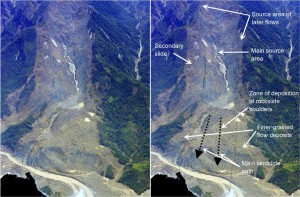23 June 2011
The seismic signature of a large landslide
Posted by Dave Petley
A little under two years ago, on 9th August 2009, Typhoon Morakot triggered a catastrophic landslide that destroyed the village of Hsiaolin in southern Taiwan, killing over 400 people. I covered this event in detail at the time and later that same year visited the site. There is a presentation about the typhoon and landslide online that can be downloaded. The journal Natural Hazards and Earth System Science has just published a paper by Feng (2011) that examines the seismic signal of the landslide. This journal is open access, so the paper can be downloaded from here.
 The analysis of the seismic signals associated with landslides is a very interesting research area at the moment. The mechanics of a landslide mean that they have a distinctly different spectral signature to that of earthquakes, meaning that very large events can be detected using global seismic arrays. This provides the possibility of the remote detection of large landslides. Furthermore, analysis of the data can provide information about the time of initiation of the movement and of the duration of the motion, which in turn can be used to analyse landslide velocity. In fact the Hsiaolin landslide demonstrates the value of such an approach – in the immediate aftermath of the Hsiaolin event there was considerable uncertainty as to whether a large landslide had actually occurred, followed by a national scandal over the tardiness of the governmental response. However, our understanding of the seismic signal of large landslides remains poor.
The analysis of the seismic signals associated with landslides is a very interesting research area at the moment. The mechanics of a landslide mean that they have a distinctly different spectral signature to that of earthquakes, meaning that very large events can be detected using global seismic arrays. This provides the possibility of the remote detection of large landslides. Furthermore, analysis of the data can provide information about the time of initiation of the movement and of the duration of the motion, which in turn can be used to analyse landslide velocity. In fact the Hsiaolin landslide demonstrates the value of such an approach – in the immediate aftermath of the Hsiaolin event there was considerable uncertainty as to whether a large landslide had actually occurred, followed by a national scandal over the tardiness of the governmental response. However, our understanding of the seismic signal of large landslides remains poor.
The Feng (2011) paper is a welcome contribution to this area, not least because Taiwan operates a remarkably dense array of strong motion instruments. This means that the seismic dataset for Hsiaolin is remarkably good. The paper examines the strong motion record from six broadband seismometers located close to the landslide. The key finding is that the landslide was clearly detectable on the strong motion instruments, and had a very different spectral signature (with the energy being concentrated at 0.5 to 1.5 Hz) to that of earthquakes of a similar magnitude. The stations located closest to the landslide indicated that the movement lasted for about 98 seconds, and movement started at 06:16 local time. However, the more distant stations produced notably less good data because of the rapid attenuation of the seismic signals.
As such, this paper is a really interesting contribution to our understanding of the seismic signature of landslides. There is some really very interesting work being undertaken by Colin Stark and Goram Ekstrom at Columbia University exploring the feasibility of a global assessment of very large landslides through remote observation via the global seismic network; this is a fascinating research area that is going to yield some great results in the next few years.
Reference
Feng, Z. (2011). The seismic signatures of the 2009 Shiaolin landslide in Taiwan Natural Hazards and Earth System Science, 11 (5), 1559-1569 DOI: 10.5194/nhess-11-1559-2011


 Dave Petley is the Vice-Chancellor of the University of Hull in the United Kingdom. His blog provides commentary and analysis of landslide events occurring worldwide, including the landslides themselves, latest research, and conferences and meetings.
Dave Petley is the Vice-Chancellor of the University of Hull in the United Kingdom. His blog provides commentary and analysis of landslide events occurring worldwide, including the landslides themselves, latest research, and conferences and meetings.
[…] in my view one of the most fascinating areas of landslide research at the moment is that of the seismic signals that they generate. Large, fast landslides, especially those formed from rock, are sufficiently energetic that they […]
[…] event in previous posts, and indeed visited the largest landslide later that year. I have also previously featured a paper that examined the seismic signal of the largest landslide triggered by t… (Feng et al. 2010), the landslide at Shiaolin, which is shown […]